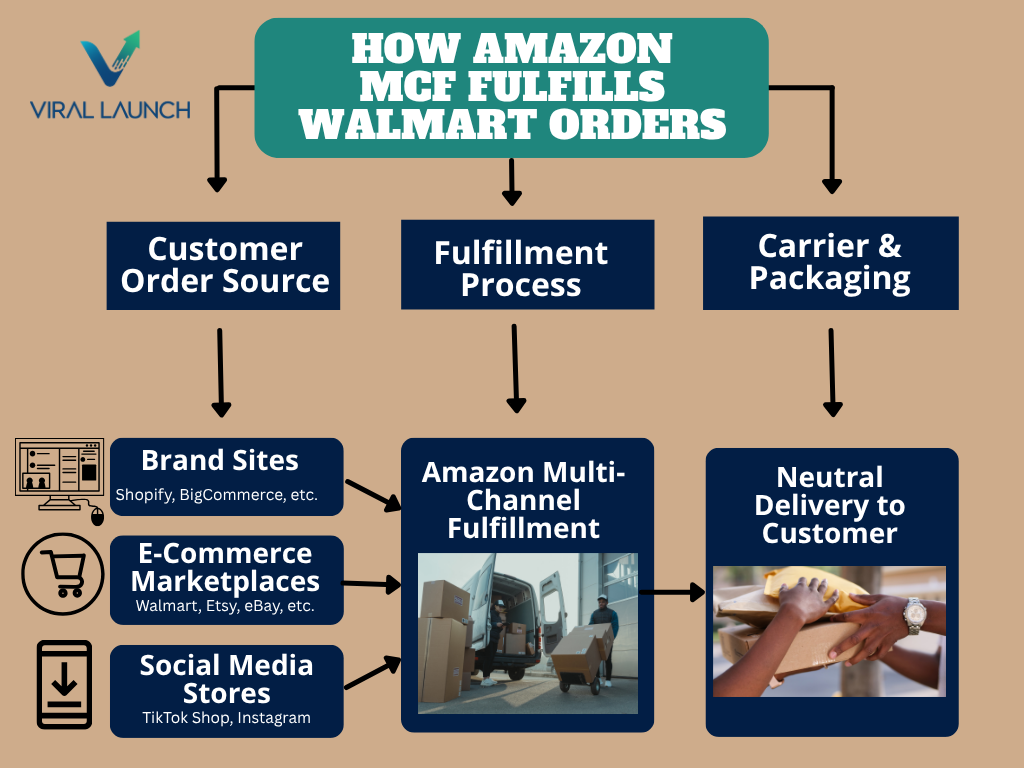If you’ve ever juggled inventory between Amazon and Walmart, you know the frustration of managing dual fulfillment systems. That headache has just ended, as a recent update to Walmart’s policy now officially allows the use of Amazon FBA for Walmart.
Walmart confirmed the change by updating its Marketplace guide, stating, “Can I use Amazon Multi Channel Fulfillment (MCF)? Yes. When using Amazon MCF, you must ship the items in a neutral box and block Amazon Logistics as a carrier to ensure orders aren’t delivered using Amazon-branded vehicles and to comply with Walmart’s shipping and fulfillment policy.”
This groundbreaking policy change means you can leverage Amazon’s world-class logistics network to fulfill orders across both platforms simultaneously. Walmart permits sellers to fulfill Walmart orders directly through Amazon’s FBA system, creating the first truly seamless multichannel fulfillment solution for major marketplace sellers.
If you’re wondering how this works, what the restrictions are, and how to set it up, you’ve come to the right place. We’ll walk you through everything you need to know about how to sell on Walmart using Amazon FBA, including a step-by-step implementation guide.
Key Takeaways
Before we get into the weeds, here’s what you need to know:
1. Cross-Platform Fulfillment is Now Official
Walmart now allows sellers to fulfill Walmart Marketplace orders using Amazon’s Multichannel Fulfillment (MCF) service, marking the end of years of platform restrictions.
2. Strict Compliance Requirements Apply
The Walmart Multichannel Fulfillment (WMFC) integration, which enables sellers to utilize FBA on the Walmart Marketplace, requires strict adherence to packaging, branding, and service standards.
3. Setup Involves Both Platform Configurations
The integration process requires coordinating settings between the Walmart Seller Center and Amazon Seller Central, including SKU mapping and aligning shipping options.
4. Operational Benefits Drive Competitive Advantage
Sellers gain unified inventory management, reduced fulfillment overhead, and access to Amazon’s logistics infrastructure without maintaining separate warehouse operations.
What Does “Amazon FBA for Walmart” Mean for Sellers?
Walmart’s announcement centers on its Walmart Multichannel Fulfillment (WMFC) program, which enables sellers to utilize Amazon’s Multichannel Fulfillment (MCF) service to fulfill Walmart orders. This WMFC Amazon Integration represents a fundamental shift in cross-platform fulfillment capabilities, allowing sellers to leverage Amazon’s infrastructure for Walmart marketplace orders. In simpler terms, you can use fulfillment by Amazon for Walmart marketplace orders. Before this update, sellers who attempted to use FBA to ship orders on Walmart’s marketplace would be subject to suspension or a ban.
Before this update, sellers were faced with a difficult choice: either miss out on Walmart’s growing marketplace or deal with the headache of splitting inventory and managing two separate fulfillment systems. Now? You can have the best of both worlds. Walmart actively penalized sellers who attempted to use Amazon FBA for Walmart orders, thereby creating a distinct line of demarcation between the two platforms.
That barrier has finally fallen. With the policy update that allows a Walmart Marketplace integration for Amazon, sellers no longer have to choose between Amazon FBA or Walmart WFS. Instead, they can now maintain all their inventory in Amazon’s fulfillment centers while seamlessly serving customers on both Amazon and Walmart. This eliminates the need for duplicate inventory management, separate shipping arrangements, and the constant headache of coordinating between two different logistics systems.
Benefits of Using Amazon FBA to Fulfill Walmart Orders
Faster, More Reliable Shipping: Amazon’s fulfillment network is one of the most sophisticated in the world, boasting a 97% on-time delivery rate that has revolutionized e-commerce with its speed and reliability. Your Walmart customers receive the same fast, reliable shipping they expect from Amazon Prime, which translates to higher customer satisfaction and improved seller metrics.
Enhanced Customer Satisfaction: Consistent, professional fulfillment across both platforms means better reviews and higher seller ratings. Largely due to the speed and accuracy outlined above, Amazon MCF often leads to happy shoppers who are more likely to return to the platform and shop. For Walmart Marketplace sellers, this is critical, as performance metrics directly impact visibility and sales.
Reduced Overhead and Warehouse Costs: Instead of maintaining separate inventory for each platform or paying for multiple fulfillment services, sellers can consolidate their operations. This reduces storage costs, simplifies inventory management, and eliminates the need for separate logistics partnerships.
Ability to Scale Rapidly and Efficiently: When you’re ready to expand to new marketplaces, your fulfillment infrastructure is already in place. This removes one of the biggest barriers to multichannel selling, allowing you to focus on marketing and product development instead of logistics.
Pro Tip: Use Walmart analytics to refine your multichannel strategy.
Restrictions Sellers Must Follow Using Amazon FBA for Walmart Orders
Although Amazon FBA integration offers significant benefits, it’s just one of several Walmart seller fulfillment options, and it comes with its own set of requirements. Walmart’s comprehensive seller guidelines enforce strict packaging, branding, and service standards to protect the customer experience. Below, we’ll explain how to sell on Walmart using FBA while navigating the key restrictions and compliance hurdles involved in this integration.
Packaging and Branding Limitations: This is perhaps the most critical restriction. Walmart orders fulfilled through Amazon MCF cannot use Amazon-branded packaging. The packages must be plain or neutral-branded to maintain Walmart’s customer experience. Amazon provides blank packaging options specifically for multichannel fulfillment.
Inventory Syncing and Tracking Accuracy Requirements: Your inventory levels must be accurately synchronized between platforms. Overselling due to inventory discrepancies can result in account suspension on Walmart. The integration requires real-time inventory updates to prevent stockouts or overselling situations.
Delivery and Customer Service Standards: Walmart maintains specific delivery timeframes and customer service expectations. Your Amazon MCF fulfillment must meet these standards, including delivery confirmations, tracking information, and return processing procedures.
Explicit Compliance and Monitoring Procedures: Walmart actively monitors fulfillment performance for sellers using third-party providers. This includes tracking delivery times, packaging quality, and customer satisfaction metrics. Failure to meet these standards can result in removal from the WMFC program.
Product Category Restrictions: Certain product categories may be prohibited from using Amazon MCF for Walmart fulfillment. This includes hazardous materials, oversized items, and products with specific handling requirements that don’t align with Amazon’s multichannel fulfillment capabilities.
Pro Tip: Maximize your Walmart listing performance from day one with LaunchGPT’s Walmart Listing Generator, which creates optimized product copy that adheres to Walmart’s guidelines, driving increased visibility and sales.
Step-by-Step Guide: How to Set Up Amazon FBA for Walmart Orders

If you plan on taking advantage of this new opportunity by connecting your Amazon FBA fulfillment for Walmart orders, you can work with a third-party service to handle it for you at a price. But setting it up manually is very doable, and can be completed in around an hour if you’re familiar with the platforms and have a clean SKU list, assuming you’re connecting existing stores on both marketplaces.
During setup, please pay attention to detail and avoid mindlessly checking boxes, as each step ensures that your inventory, orders, and customer experience are aligned across both platforms. Miss a single detail, and you could risk order delays, account suspensions, or mismatched listings. Follow this carefully to get it right the first time, saving yourself the time and risk of setbacks for your business, and enabling you to move forward toward multichannel mastery.
Step 1. Enable and Configure Amazon MCF
Navigate to: Multi-Channel Fulfillment (found in your main dashboard menu)
Core MCF Configuration
- Enable the service – Click “Enable Multi-Channel Fulfillment” (no additional sign-up needed if you’re already using FBA)
- Configure critical packaging settings:
- Packaging preference: Select “Ship without Amazon packaging” (unbranded packaging) – this is mandatory for Walmart compliance
- Carrier restrictions: Block Amazon Logistics as a delivery carrier for Walmart orders to comply with branding rules
- Use your business address as the return address.
- Set fulfillment preferences:
- Configure default fulfillment speed options
- Enable/disable Saturday delivery based on your service level commitments
- Set up automated shipping confirmations through neutral channels
These settings ensure that every MCF order automatically complies with Walmart’s requirements, eliminating the need for you to select the correct options each time manually.
Step 2: Set Up Third-Party Integration
Although you can connect your Amazon MCF process to Walmart, MCF does not connect directly to Walmart Seller Center. Instead, you’ll need a third-party connector. You can think of this third-party integration like DoorDash, as it serves as a necessary middleman to get your meal to your house from restaurants without in-house delivery.
Also like DoorDash, these third-party integrations aren’t just legal, but recommended by the platforms, so there are no worries about breaching any seller guidelines. However, you must use a supported order management integration to automatically route Walmart orders to Amazon MCF.
Choose Your Integration Method
Recommended platforms:
- WebBee – Comprehensive automation with real-time sync
- Veeqo – Multi-channel inventory management focus
- Listing Mirror – Robust cross-platform listing tools
- Custom API integration – For advanced sellers with development resources
Integration Setup Process
- Authorize API access – Set up SP-API credentials in Amazon Seller Central under Apps & Services → Develop Apps
- Configure automatic routing – Enable seamless order flow from Walmart to Amazon MCF
- Enable real-time tracking sync – Ensure shipping updates flow back to Walmart customers
- Set up inventory synchronization – Keep stock levels accurate across both platforms
Step 3: Configure Shipping and Inventory Management
- Shipping Speed Mapping
– Walmart Standard (3-5 days) → Amazon MCF Standard
– Walmart Expedited (2-3 days) → Amazon MCF Priority
– Walmart Two-Day → Amazon MCF Expedited
– Walmart Next Day → Not available through MCF (disable this option)
Inventory Synchronization Setup
- Enable real-time inventory sync between platforms
- Configure safety stock buffers – maintain 10-15 units minimum to prevent overselling
- Set up low-stock alerts for proactive inventory management
- Reserve inventory allocation – ensure MCF orders don’t conflict with Amazon sales
Step 4: Implement Walmart Compliance Requirements
These settings are non-negotiable for maintaining your Walmart seller status:
- Amazon Logistics blocking – Must be disabled for all Walmart orders (prevents Amazon-branded vehicles/packages)
- Unbranded packaging enforcement – All outbound shipments must use neutral packaging
- Tracking upload protocols – Only submit tracking numbers to Walmart after the carrier has physically picked up the package
- Performance adherence targets:
- On-Time Delivery Rate: Maintain ≥95%
- Valid Tracking Rate: Maintain ≥99%
- Order processing time: Maximum 24 hours from order receipt
Customer Communication Standards
Additionally, ensure that your customer communication methods align with your marketplace’s guidelines, providing customers with clear and straightforward information about their orders.
- Disable Amazon-branded notifications for MCF orders
- Route all customer service through Walmart’s systems
- Configure return instructions to direct customers to Walmart’s return process
- Ensure neutral shipping confirmations that don’t reference Amazon
Step 5: Product Mapping and SKU Configuration
Bulk Product Setup
Navigate to: Products → Manage Inventory in Walmart Seller Center
- Select eligible products:
- Filter for FBA-eligible items with sufficient inventory
- Ensure a minimum 30-day supply on hand
- Verify products aren’t restricted or hazmat classified
- Configure fulfillment settings:
- Set fulfillment provider to “Amazon MCF” via your integration tool
- Validate that Amazon ASINs match corresponding Walmart product listings
- Confirm dimensions and weights are accurate for shipping calculations
Step 6: Comprehensive Pre-Launch Testing
After Step 5, you should be all set up for success using Amazon FBA to fulfill orders made through the Walmart marketplace. However, it’s always best to check your work before finalizing anything.
- Place a test order on your Walmart listing
- Timing verification: Confirm the order appears in Amazon Seller Central within 15 minutes
- Status tracking: Ensure progression from “MCF – Processing” to “Preparing for Shipment” within 24 hours
- Carrier confirmation: Verify non-Amazon Logistics carrier assignment
When conducting your test order, monitor these essential validation points to ensure seamless MCF integration: verify that all customer communications flow through Walmart’s branded channels, confirm unbranded packaging and neutral carrier delivery, validate proper tracking integration between platforms, and test that delivery timing meets service commitments. You may even want to consider returning the item to test the full process.
FAQs
Can I use my Amazon-branded boxes for Walmart orders?
No, this is strictly prohibited. Walmart orders must be fulfilled using plain or neutral packaging to maintain the Walmart customer experience. Amazon provides blank packaging options specifically for multichannel fulfillment.
How long does Walmart take to approve sellers for integration?
Approval times vary, but typically range from 3-7 business days. Walmart reviews your seller performance, account standing, and compliance with their marketplace policies before approving WMFC access.
What happens if Walmart customers return Amazon-fulfilled products?
Returns are handled through Walmart’s standard return process. However, the returned inventory goes back to Amazon’s fulfillment centers. You’ll need to coordinate between both platforms to manage return inventory and refund processing.
Is it expensive to use Amazon MCF for Walmart fulfillment?
Yes, Amazon MCF fees are higher than standard FBA rates, as you’re fulfilling orders for external channels. However, the costs often balance out through increased sales volume and operational simplification. The good news? Amazon has temporarily waived the 5% surcharge for Walmart MCF orders through January 14, 2026, making this strategy more attractive for sellers looking to expand their multichannel reach.
Are there specific products Walmart prohibits through Amazon MCF?
Yes, certain categories, including hazardous materials, oversized items, and products requiring special handling, may be subject to restrictions. Always check Walmart’s current guidelines and Amazon’s MCF restrictions before listing products.
Final Thoughts
This new integration is a huge win for multichannel sellers. If you’re already using FBA, expanding to Walmart just got a whole lot easier. No more managing separate inventories or stressing over two logistics systems. Simply set it up once and let Amazon handle the heavy lifting, both literally and figuratively.
If you’ve been sitting on the sidelines for starting an e-commerce business through FBA, consider this policy update as a stronger selling point to get in the game. For newcomers to e-commerce, this means you can focus on sourcing and marketing instead of managing warehouses, making it easier to expand your business to marketplaces where the most customers are, with minimal impact on your workload.
For sellers already established on Amazon, this integration provides a streamlined path to success on Walmart Marketplace. The ability to maintain unified inventory, reduce operational complexity, and scale efficiently across platforms provides a competitive advantage that’s hard to ignore.
The key to success lies in carefully following Walmart’s guidelines, properly setting up the integration, and continuously monitoring performance metrics across both platforms. When executed properly, this strategy can significantly expand your market reach while maintaining operational efficiency.








